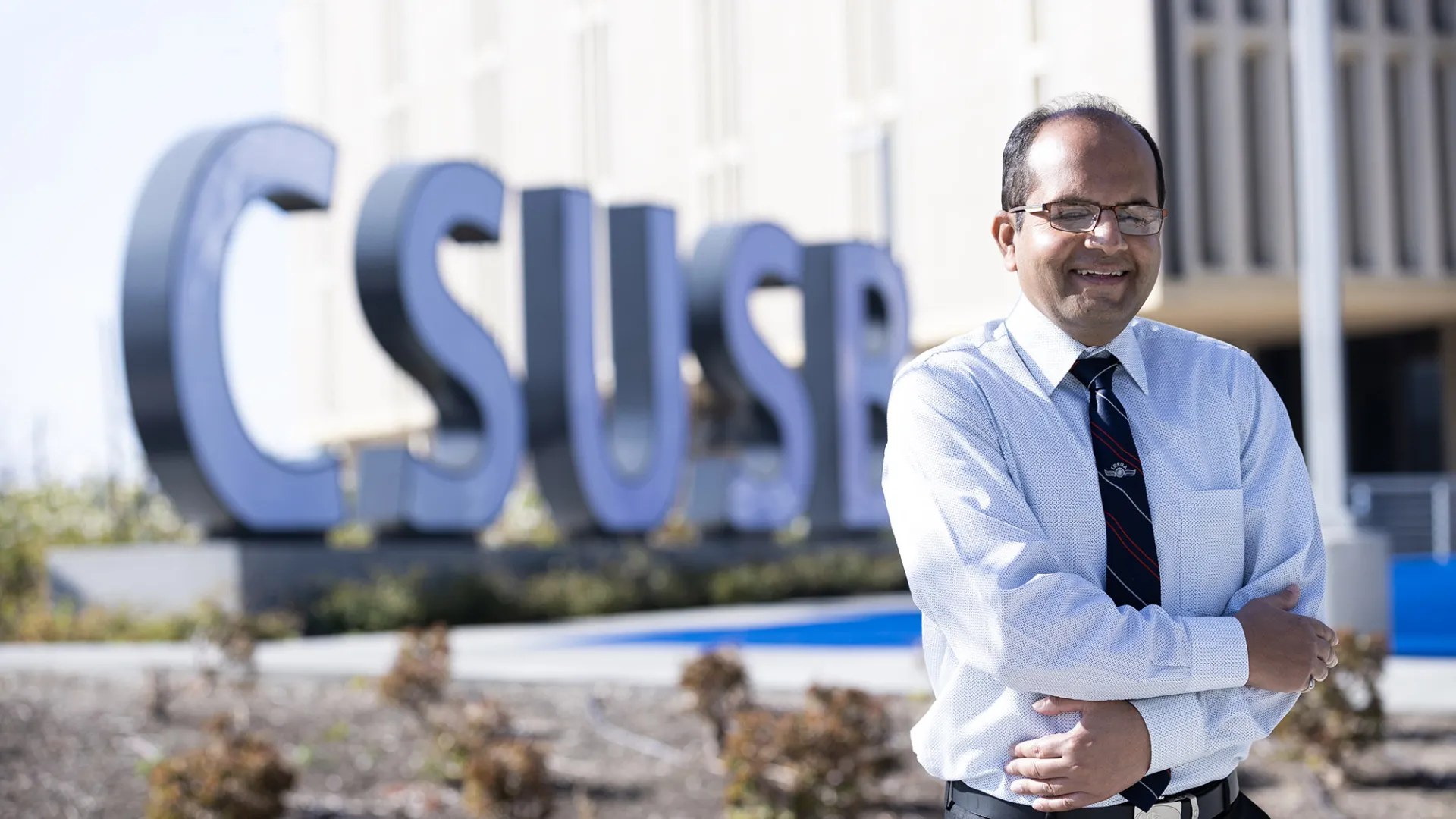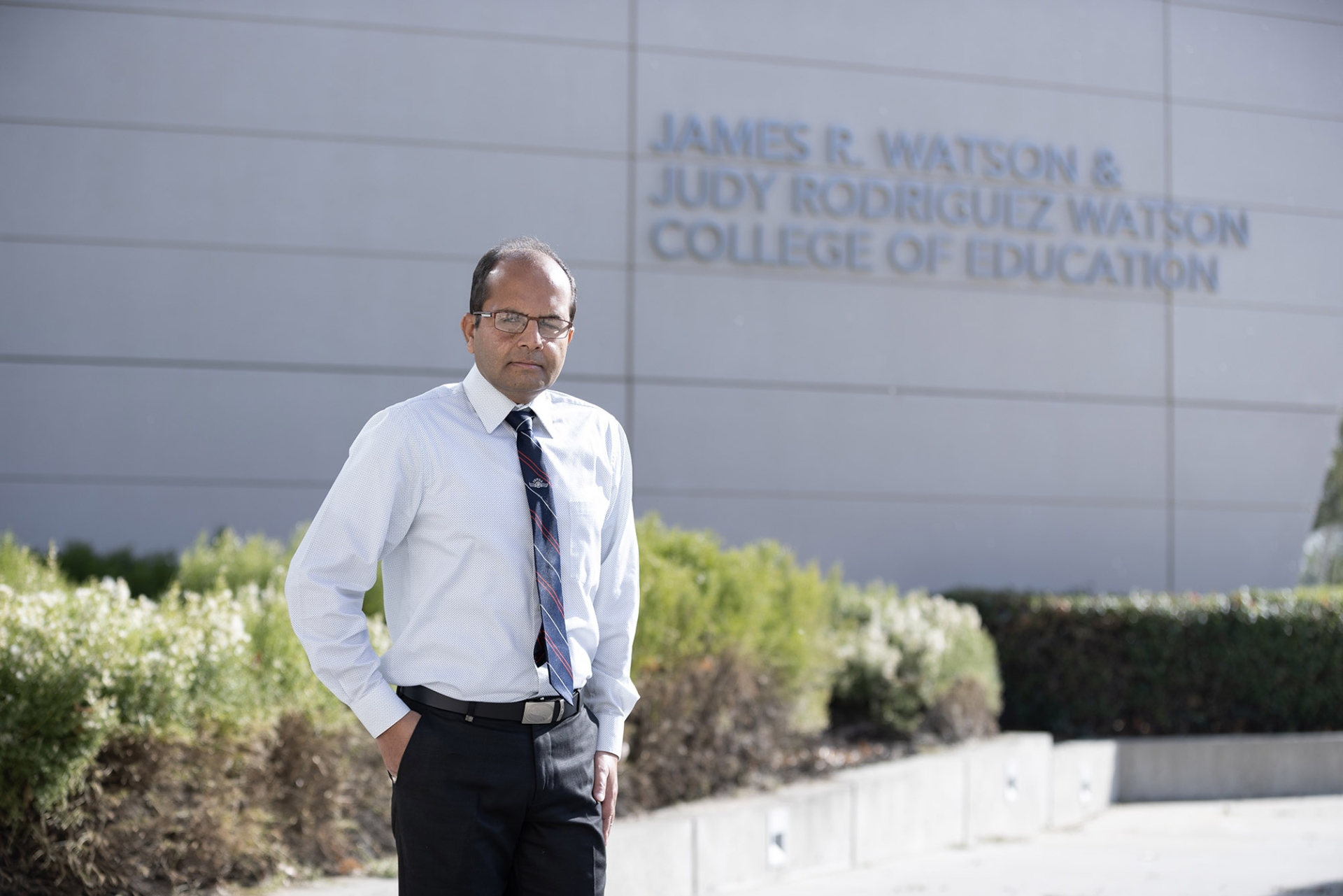Alan Llavore | Office of Strategic Communication | (909) 537-5007 | allavore@csusb.edu

Abbas “Bobby” Quamar, associate professor of special education, rehabilitation and counseling at Cal State San Bernardino, has developed the world’s first clinical assessment tool, called EISA, to help persons with disabilities find the most suitable internet-connected assistive device (iCAD), such as smart phones and tablets, based on their needs and preferences. A study describing the first-of-its-kind evaluative tool was recently published in the American Journal of Occupational Therapy, November/December 2023 issue.
But for Quamar, this is just the latest in a series of remarkable achievements few people can claim, a triumph with roots grounded in a tragic accident.
In 1996 at age 22, Quamar, an airline pilot, became blind following a midair accident.
His journey since that time has been one of resilience, determination, tenacity and inspiration.
From his earliest memories, Quamar recalls being fascinated by airplanes, flight and space travel. Whenever possible, he’d ride his bicycle the 10 to 12 miles to the airport in his hometown of Indore in central India to observe the three or four flights that touched down each day, watching in fascination as they taxied along the tarmac.
He built remote-controlled airplanes in school, joined the city’s flying club and earned his student pilot license. He joined the National Cadet Corps, the air wing of India’s National Armed Forces, which provided the funding for his private pilot license. Soon after, he was selected to join the Indira Gandhi National Flying Academy to complete training for a commercial pilot’s license, the final step before becoming a pilot for a large commercial airline.
On March 23, 1996, as Quamar was preparing to leave flight duty for the day, he and a fellow captain were called in to ferry several VIPs from a city in Northern India to the northeast part of the country. But as they approached their final destination, a low-flying vulture struck the aircraft’s windshield, shattering the plexiglass and sending shards and small splinters of glass throughout the cockpit. “My nose was broken, my jaw was broken, and some of those splinters went straight into my eye,” he said.
The aircraft made an emergency landing, Quamar was rushed to a local hospital and then flown for emergency treatment to a specialty hospital in Delhi. For the next six months, his parents searched for a treatment to restore his vision and learned of a world-renowned surgeon in Belgium, who agreed to treat Quamar. But after undergoing surgery, the results were disappointing.
“Because of the delay in treatment, the results were minimal,” he said. “I could see different colored lights but couldn't see any shapes.
“That was the end of my flying career. Now, I was more or less groping in the dark about what to do with my life. It was a shock for me and my entire family.”

The aftermath of the accident plunged Quamar into a period of uncertainty and depression. It was his mother's unwavering support and encouragement that became his guiding light during these dark times.
“She told me, ‘I’m not going to give you any special treatment,’ but she would continuously encourage me, saying ‘You have to find a way. You've got to try. We don't know the right direction, but we know for sure that unless you try, nothing is going to happen. Eventually we'll figure the right way out.’”
This marked the beginning of a formal and informal rehabilitation phase. He worked with the Blind Institute of India and learned Braille in only six weeks. He began what became a seven-year career in a complementary medicine clinic, eventually becoming the manager.
He went on to earn a degree in tourism studies from India’s National Open University. With no assistive technologies available to him at the time, his mother would read and record his textbooks on audiotapes for him, which often took two to three hours each evening after she returned home from her job as a school principal. He listened to the lessons for hours, committing them to memory. The university required all assignments to be handwritten, and a friend patiently transcribed all the assignments on Quamar’s behalf.
In 2003, he applied to the Royal National College for the Blind in the UK and was awarded a $25,000 scholarship, which covered only one-fourth of the tuition. Determined to bridge the financial gap, he wrote letters to philanthropic organizations, businesses, and even the queen of England, to raise the tuition money. Ultimately, his religious organization was able to raise enough to pay half the tuition, and he worked at the campus snack bar to further subsidize the cost of his education.
“When I went to the Royal National College for the Blind, they gave me orientation and mobility training – how to walk around on your own, how to cross streets, get on the bus, go to the store and do your shopping, how to iron your clothes on your own or to cook food on your own. Basically, how to be independent,” he said.
Graduating from the Royal College signaled a major turning point in his life. Recognizing the pivotal role that rehabilitation played in his journey, he decided to make it his career path. “During all the years of my treatment and rehabilitation, so many people who didn’t know me went out of their way to help me. I thought, ‘What have I done in this world? It's my time now. It's payback time. I have to do something to help others.’”
He moved to the U.S. in 2008, enrolled at the University of Pittsburgh and earned a bachelor’s degree in rehabilitation science in 2009, then a master’s degree in rehabilitation counseling in 2013.
“Sadly, my mother, the person who inspired me and encouraged me to pursue a Ph.D., died of end-stage liver disease in 2017, the year before I earned a Ph.D. in rehabilitation science and technology,” he said. In 2018, Quamar became an assistant professor of rehabilitation counseling at the University of Arkansas at Little Rock, where he taught until joining CSUSB in 2021.
Quamar's personal and professional story, punctuated by personal challenges and triumphs, not only reflects his own resilience but also embodies his commitment to making a positive impact in the field of rehabilitation.
“During this entire journey, after my accident, the thing that opened doors for me in education and employment was assistive technology, like talking computers and talking phones, which are internet-connected assistive devices (iCADs) and devices using artificial intelligence,” Quamar explained.
Electronic Instrumental activities of daily living Satisfaction Assessment (EISA) is the world’s first clinical assessment tool to help persons with disabilities find the most suitable iCAD based on their needs and preferences, Quamar said. EISA consists of a set of 10 questions that ask those with disabilities how they will be able to complete their “everyday activities such as transportation, banking, shopping, leisure, education, employment, nutrition, medication management, and how you can complete all of these using iCADs so that they can tap their optimal potential,” he added.
“In this age of continually connected lifestyles, using contemporary iCADs is pivotal for enabling persons with disabilities to live independently in society and achieve a high quality of life,” said Quamar. “It really makes a difference when you can do something that helps bring a change in the lives of others.”